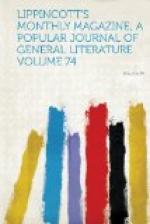It is impossible to bring up separately, in a single article, the items contained in a volume of 603 pages, so we must be content to leave Mr. Massey’s theory with these meagre allusions to its principal statements, and pass on to that of Mr. Charles Armitage Brown. Upholding the opinion that the Sonnets are autobiographical, he maintains that they are in reality not sonnets, but poems in the sonnet stanza, there being but three sonnets, properly so called, in the series. The poems are six in number, terminating each with an appropriate envoi, and are addressed, the first five to the poet’s friend, “W.H.,” and the sixth to his mistress. That friend must have been very young, very handsome, of high birth and fortune; and to all this the description of William Herbert exactly answers. The divisions made by Mr. Brown are as follows: First poem, 1 to 26—to his friend, persuading him to marry. Second poem, 27 to 55—to his friend, who had robbed the poet of his mistress, forgiving him. Third poem, 56 to 77—to his friend, complaining of his coldness, and warning him of life’s decay. Fourth poem, 78 to 101—to his friend, complaining that he prefers another poet’s praises, and reproving him for faults that may injure his character. Fifth poem, 102 to 126—to his friend, excusing himself for having been some time silent, and disclaiming the charge of inconstancy. Sixth poem, 127 to 152—to his mistress, on her infidelity. In this last poem, says Mr. Brown, we find the whole tenor to be “hate of my sin grounded on sinful loving.” However the poet may waver, and for the moment seem to return to his former thralldom, indignation at the faithlessness of his mistress and at her having been, through treachery, the cause of his estrangement from a friend, at the last completely conquers his sinful loving. “For myself,” continues Mr. Brown, “I confess I have not the heart to blame him at all, purely because he so keenly reproaches himself for his own sin and folly. Fascinated as he was, he did not, like other poets similarly guilty, directly or by implication obtrude his own passions on the world as reasonable laws. Had such been the case, he might have merited our censure, possibly our contempt.”




